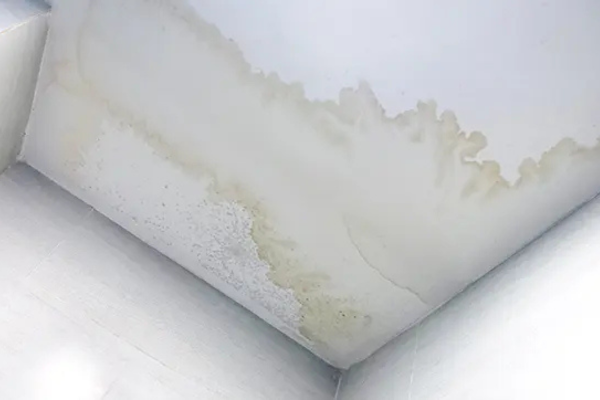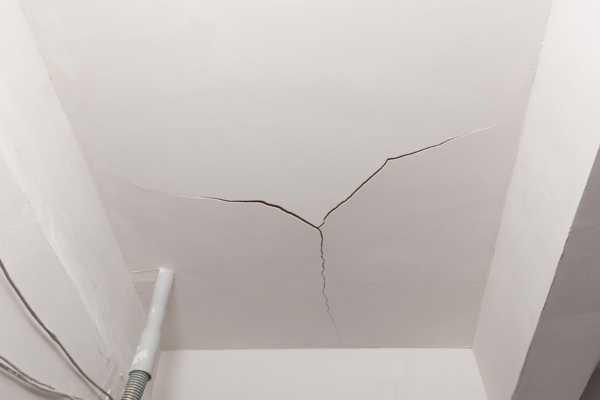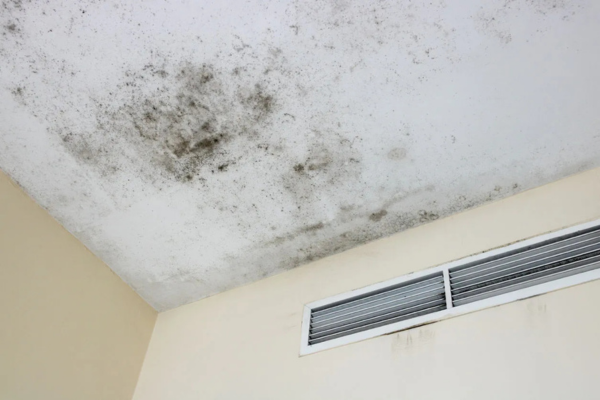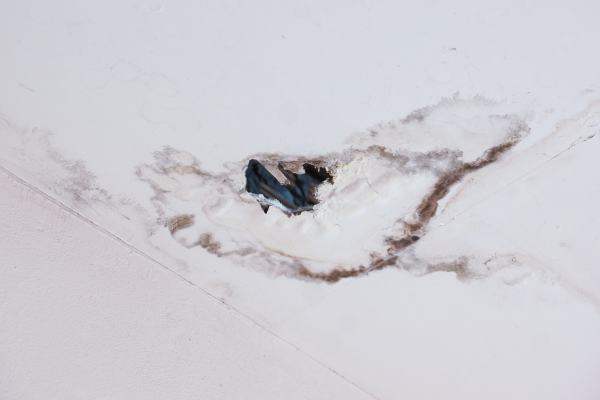Water damage on the ceiling is much more than an eyesore; it usually acts as a warning to more serious issues in your home. To the average homeowner, the ability to recognize the early signs of ceiling water damage will save them thousands of dollars in repair costs and prevent health hazards such as mold and mildew. Common sources of water damage, not limited to, involve roof leaks, plumbing problems, and condensation issues with the HVAC. Knowing these causes can aid you in detecting water damage as soon as possible so that you may take further actions to keep your house safe and sound.
If water leakage onto the ceiling is left unattended, it may prompt structural damages, growth of molds, and even worse-devaluation of your property. In this article, we will look at some of the leading causes of ceiling water damage and what you should look out for.
What Causes Ceiling Water Damage?
Knowing the causes of the ceiling water damage will enable you as a homeowner to know where to look and how to fix a problem before it gets any worse. There are several possible sources of ceiling water damage, each with associated identifying marks and risks. Let’s explore the most common causes in more detail below.
Roof Leaks: Broken or Missing Shingles, Gutters Clogged and Poor Insulation
Leaks in the roof are some of the most common sources of ceiling water damages. Any broken and missing shingles on your roofing can allow water to pass through, wreaking havoc on either ceilings or walls. Usually, roof leaks occur when:
- Shingles are broken or missing: Whenever there is damage to your shingles, it automatically leads to the allowing of water into your home, leading to moisture building up onto your ceiling.
- Clogged gutters: Gutters can be easily clogged by leaves and other forms of debris, whereby rainwater will not be able to flow through; this may lead to overflows that can soak your roof and ceiling.
- Poor insulation: Poor insulation lets the buildup of moisture take place, increasing the risk of water seeping through and eventually causing damage to ceilings.
The regular maintenance or inspection will prevent roof leakage, especially after storms or heavy rainfall seasons. And at least, this inspection will help in not allowing a minor issue to turn into major damage.
Plumbing Leaks: Ruptured Pipes, Leaking Bathrooms, or Poor Plumbing:
The second most common cause of water damage is poor plumbing. More often than not, plumbers have water accumulate gradually behind the wall and ceiling, and most times, this goes unnoticed until major damage appears. Some of the main plumbing defects that cause ceiling water damages include:
- Ruptured pipes: When pipes freeze or rupture, the water leaks into walls and ceilings, causing visible damages that may further lead to structural issues.
- Leaking bathrooms: Bathroom leaks especially from showers, tubs, and toilets leak down to lower-level ceilings, creating stains, mold, and sagging.
- Poor plumbing connections: Poorly connected plumbing causes small leaks that, over some time, start to get worse and appear as active water damage on the ceiling.
Early recognition of plumbing leaks can reduce further build-up of water and minimize costly repairs in the ceiling.
HVAC and Ventilation Issues: Poorly Maintained Systems Can Cause Condensation
HVAC systems are also a major source of ceiling water damage if not properly maintained. Air conditioning units can, in particular, generate excessive condensation that can leak behind ceilings and walls when it doesn’t drain properly. The most common HVAC-related issues which cause water damages are:
- Condensation accumulation: An HVAC unit that generates condensation will need to have it drained off and away from the house. If the system’s drain becomes clogged, that water may build up until it finds its way to the ceiling.
- Leaking ductwork: Damaged or poorly sealed ductwork will cause cool or warm air to escape into areas that encourage condensation and moisture accumulation.
- Poor ventilation: Homes with inadequate ventilation systems are at a higher risk for condensation and moisture accumulation that leads to possible water damage of the ceiling.
Regular HVAC maintenance means that ducts are kept clean, while the drainage lines will be checked to prevent problems; it keeps your air and moisture balance in perfect order.
Key Signs of Ceiling Water Damage
Spotting these signs of ceiling water damage early will help you evade some pretty pricey repairs and health risks, too. Here are the key things to watch for:
Early recognition of ceiling water damage signs will help prevent extensive repairs and keep your home environment safe. Following are the most common signs that indicate water damage in your ceiling:
Water Stains and Discoloration

First to appear as one of the most visible signs of ceiling water damage is the water stain. Most of the time, they are yellow, brown, or copper-colored and can be present around corners or near light fixtures. The stains evidence that water leaks from somewhere above the ceiling, generally due to a roof leak or a problem in plumbing.
Peeling, Cracking, or Bubbling Paint
With the collection of moisture in the ceiling, peeling, cracking, or bubbling of paint or wallpaper can occur. This mostly occurs when the paint or wallpaper lost its adhesion because of prolonged exposure to moisture, which basically informs one that water has seeped through, damaging the materials underneath.
Sagging or Bowed Ceiling

Serious signs of severe water saturation include sagging or bowed ceilings. This is because of the long-term accumulation of water pressure on the ceiling structure. At times, a sagged ceiling may feel soft or unstable to touch and might easily collapse if not given attention.
Soft Spots or Dampness
Other symptoms of water damage are soft spots in the ceiling. Press on any area that looks unusual; if it feels spongy or wet, know that it’s because of water seeping in. These can be from minor, ongoing leaks in plumbing or roofing problems.
Persistent Musty Odor
A musty or damp smell in a room usually signifies that there is some secret water damage. The odors in these situations usually come from mold or mildew growth, which breeds well in moistly trapped areas. Mold can be highly injurious; it destroys not only the surfaces but can even cause respiratory problems.
Visible Mold or Mildew Growth

Mold growth comes in the form of black, green, or grayish spots on or around the ceiling. Basically, it is an indication that water has been touching something for a long period. Most of the time, mold spreads fast, especially in areas where ventilation is poor. Furthermore, if mold is not removed on time, it may cause several health hazards.
Droplets or Active Water Accumulation
Water dripping from, or collecting in droplets on, the ceiling surface indicates an active leak and any such instance should be addressed immediately. It may point to something more serious, like a burst pipe or severely damaged roof; hence, a person should try to have it serviced as soon as possible to avoid further damage to ceilings or structural elements of the house.
Cracking or Warping in the Ceiling Surface
With small cracks or warping in your ceiling, it’s most likely expanding and contracting with the changes of moisture. This will continue to spread and reduce the integrity of the ceiling structure if left untargeted by finding the source of the water.
Streaking or Dripping Stains on Walls
This would, in other cases, cause water damage in the ceiling, extending down walls and creating streaking stains. This typically occurs with multi-story homes where damage to the ceiling from an upper floor can leak into the lower story walls.
Electrical Issues
Water damage in the ceiling can sometimes trickle into electrical systems and cause lights to flicker, short, or make crackling sounds. Around ceiling light fixtures or outlets, this is very common. If you notice these signs, cut the power to the area and immediately seek professional advice.
Each of these water damage indications on the ceiling requires extended observation of what really happened and to what extent. These are those chances that, if identified early enough, may prevent huge structural damages and expensive repairs.
Consequences of Neglecting Ceiling Water Damage
Ceiling water damage can lead to a plethora of life-threatening problems if left unattended. Herein is why you need to take immediate action upon such signs:
Structural Damage
Water damage to the ceiling weakens the structural elements and may cause the ceiling to fall or the beams to get damaged. If left unattended for a long time, water damage spreads to walls and floors, necessitating a more extensive and expensive repair.
Health Risks
Humid conditions favor mold and mildew. In addition, mold causes respiratory problems, especially for those with allergies or asthma. Prevention of mold growth is very important to keep the indoor climate healthy. Read more on the EPA’s guide about mold and health.
Higher Repair Costs
The longer water damage to the ceiling goes unchecked, the bigger-and more expensive-repairs will be. Performing repairs sooner rather than later saves a lot on repair costs and inhibits the spread of secondary damage further in a home.
When caught early and resolved, ceiling water damage does not pose those risks but rather allows homeowners to live in a place where no damage or risk may come their way.
What to Do If You Notice Signs of Ceiling Water Damage
Okay, if you find any sign of ceiling water damage, quick action is going to be important to avoid issues from getting much worse. Here’s what you should do next:
Things to Do Immediately
Turn Off Water: First, turn off the water supply if you suspect something wrong in the plumbing line to reduce further damage.
- Contain the Leak: Place a bucket or container under any active leaks to catch water and protect the floors.
- Document the Damage: Take photos, note affected areas of the home; this documentation may help in insurance claims and assessments.
Preventing Ceiling Water Damage in the Future
Most instances require the services of a water damage restoration company. They will perform a comprehensive check into the premises, determine where the leakage occurred, and cause professional repairs to eliminate future troubles. Professional water damage restoration services in New Jersey are highly recommended for extensive damage, as experts have the proper tools and experience to manage the restoration effectively.
Do-It-Yourself vs. Hiring a Professional: Where to Draw the Line
- Minor Repairs: A few minor problems, such as small water stains or touch-up paints, a do-it-yourselfer with the proper materials should be able to handle.
- Professional Fixes: For those serious cases of water damage, visible mold growth, or sagging ceilings, it’s best left to the professionals. They’ll be able to perform a fix that really solves the problem at hand and won’t allow the issue to return.
Frequently Asked Questions on Ceiling Water Damage
Adding an FAQ section addresses the common concerns and catches more search queries, improving the chances of ranking for long-tail keywords.
How do I know if I have water damage in my ceiling?
One of those things is to just be aware of common signs of water damage in your ceiling. For example, common signs could be water marks, blistering paint, or maybe a moldy smell. In any of these conditions, a pretty good reason for investigating further or calling a professional would be if they were visibly apparent.
What does ceiling water damage stem from?
Ceiling water damage usually emanates from roof leaks, plumbing problems, or condensation issues of HVAC. These can always be prevented through regular inspections and maintenance.
Is ceiling water damage covered by insurance?
Most instances of homeowners’ insurance cover ceiling water damage, especially if such changes in the ceiling occur suddenly or as some sort of accident. However, this would depend on your policy details, or it would be best confirmed with your insurance provider.

